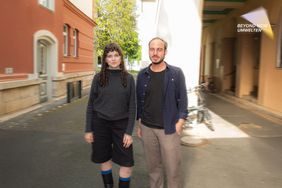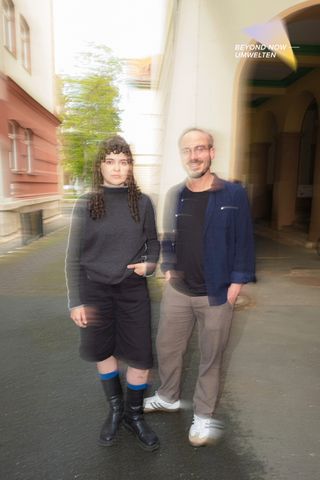BEYOND NOW – Biennial of Care: Students Generate Awareness for the »After« of Art Projects
Exhibitions, biennials, and festivals: When art temporarily takes over spaces, intense and often elaborately staged encounters occur between art, audience, and venue. But what is left over once the art disappears, the audience moves on, and the space is emptied? What social, material, and ecological traces does art leave behind? And who is responsible for taking care of them?
Students from the Faculty of Art and Design are currently examining these questions in the »When art left the scene« Bauhaus.Module. Relying on qualitative research methods, the students are developing video essays in which they interview artists, curators, producers, mediators, and other individuals involved in the art scene and ask about their experiences. They are accompanied by lecturers Giuliana Marmoaund Martin Leibinger, who lead the course, sharing the insights they’ve gained of major events. Marmo conducted a research project on the situation of art workers at La Biennale di Venezia as part of her bachelor's thesis, while Leibinger has been accompanying Manifesta since 2020 with a qualitative study for his doctoral thesis.
»We’ve realised in our work up until now that a void emerges when the art, budgets, materials, and project participants leave after a biennial, for example«, says Marmo. »A positive example of this is a group of individuals in Venice who dismantle pavilions and catalogue materials, passing it on to other artistic or socio-cultural projects as a low cost. There are, however, other empty spaces created in many places. An event generates budgets and energy, and relationships, contacts, and networks are established. This raises expectations, which then often end suddenly, leaving disillusionment or disappointment in their wake. A vacuum then threatens to emerge. How this can be filled or ›reused‹ is what interests us!«
The project doesn’t end at taking stock. Martin Leibinger explains: »In this Bauhaus.Module, the video essays are made together with the students, who bring together scenarios and experiences, focussing on social, political, and ecological aspects. We plan to bundle this together in the subsequent ›Biennial of Care‹ project in a kind of archive, making the knowledge accessible. We want to create a space where others can use this resource and expand on it with their own experiences and projects; it is intended to be an archive that grows, is scalable and can be used in many places.«
Marmo hopes the participants will a sustainably internalise this: »Our goal is actually to generate awareness among everyone involved that there is an ›after‹. The artists can already ask themselves during the conception of an artwork what should happen to it afterwards. And institutions can also think about what they’re leaving behind after a high-profile event – in addition to the ›positive image‹ portrayed to the public.«
Where the »Biennial of Care« journey leads has been deliberately left open. »We’re looking to see which of our students will continue to be involved with the project. Our archive should be portable, it should be able to travel and be fed with future experiences to expand it«, says Leibinger. The first results of this artistic and research collaboration will be presented at this year’s »summaery2025« exhibition. For the first time, the exhibition will show how diverse the »after« of the event can be conceived and implemented.
Funded by the Bauhaus-Universität Weimar as part of the »Beyond Now ⸺ Environment« annual theme and the Faculty of Civil and Environmental Engineering’s »Lighthouses@B&U« programme.
Project Coordinators: Giuliana Marmo, Martin Leibinger, Stefan Ralevic
Mentors: Jr. Prof. Alexandra Toland, Deputy Prof. Suse Weber
Text: Romy Weinhold
Photos: Richard Schött
Social Media: Marit Haferkamp
Signet: Romi Klockau
Concept and Editorial: Claudia Weinreich


